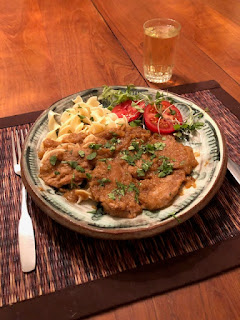Pork Tenderloin “Steaks” with Spiced
Apple
OK, so this was an
experiment: one of my favorite meats for cooking, pork tenderloin, with some of
my favorite seasonings, even if they don’t usually go together. It was a chilly
evening right now, so this hearty though fairly easy dish fit well for dinner.
It seems like something that should be Central European, maybe German or Czech
or Hungarian, but if it is, that’s a coincidence.
Currently pork tenderloin is
often a screaming bargain meat. Much cheaper, usually, than pork chops – which incidentally I find
difficult to cook without being dry, tough and dull. Tenderloins are packaged
two to a container, and typically weigh between one and one and a half pounds
each, They have very little waste, and take limited time to cook. But they can
be herb-rubbed and roasted, chunked and made into a quick and elegant stew,
thinly sliced for Asian stir-fried dishes, made into kebabs, and cut in 1/4-1/2 inch “steaks” for quick frying or
braising. I don’t understand why they are often on special, say
buy-one-get-one-free sorts of deals. I’m guessing that many people don’t know
how to cook them. Hey, that works for me.
Here’s my chilly January
dinner creation: “Pork Tenderloin Steaks with Spiced Apple“ It goes well with
buttered egg noodles and either a green vegetable or a simple salad. The recipe
serves four. A light-bodied red wine or a hearty white go with it.
1 small-medium pork
tenderloin (half of a package),about 1-1/4 pounds
Seasonings: 3/4 tsp salt +
1/4 tsp black pepper.+ 4 teaspoons flour
2 medium apples
1/4 small onion
2 tablespoons olive oil for
pork plus 2 for the sauce
2 tablespoons white wine
4 tablespoons water, plus
more as needed
1 teaspoon Worcestershire
sauce
1 teaspoon prepared
horseradish
3/4 teaspoon salt
1/2 teaspoon paprika
1/4 teaspoon black pepper
1/2 teaspoon sugar
A pinch of cayenne
Chopped cilantro or parsley
for garnish
Trim off any fibrous or fatty
parts off the pork. Cut the meat across into 1/2-inch thick slices. Sprinkle on
both sides with the salt-pepper-flour mix. Peel the apples, quarter and core
them and cut the flesh into 1/4-inch slices. Thinly slice the quarter onion.
Heat a large frying pan to
medium hot. Add 2 tablespoons olive oil, then fry the pork pieces in a single
layer, turning them after they start to brown. When lightly browned on both
sides, transfer them to a plate.
Add the other 2 tablespoons
olive oil to the pan. Fry the onion, stirring and scraping frequently, until
softened. Add the apple and fry 2-3 minutes, stirring and scraping. Then add
the wine, water, and all the seasonings (not the garnish), and stir and fry as
the apple cooks down, 5-7 minutes.
Add back the previously
seared pork and combine well. Keep the pork in a single layer, and simer 5-7
minutes, covered but turning frequently and adding a little water as needed,
until pork is tender (cut off a little piece of one to test by biting). Taste
the sauce for salt, and add a little as needed.
Serve with buttered noodles, plus either a green vegetable or salad. Sprinkle the chopped cilantro or parsley over the pork.


















